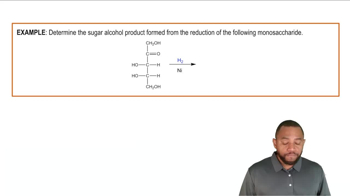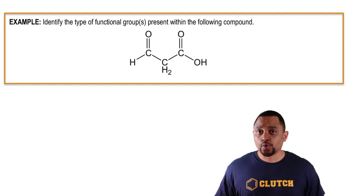Isomaltose, a disaccharide formed during caramelization in cooking, contains two glucose units bonded α (1→6) . Draw the structure of isomaltose.
Ch.6 Carbohydrates–Life’s Sweet Molecules
Chapter 3, Problem 10a
Classify each of the following monosaccharides by the type of carbonyl group and the number of carbons (for example, a monosaccharide with an aldehyde and three carbons is an aldotriose).
(a) <IMAGE>
 Verified step by step guidance
Verified step by step guidance1
Identify the functional group present in the monosaccharide. Look for a carbonyl group, which can be either an aldehyde (\(\text{-CHO}\)) or a ketone (\(\text{C=O}\)).
Count the number of carbon atoms in the monosaccharide. This will help determine the prefix for the name (e.g., triose for three carbons, tetrose for four carbons, etc.).
Combine the type of carbonyl group with the number of carbons to classify the monosaccharide. For example, if the carbonyl group is an aldehyde and there are three carbons, it is an aldotriose.
If the carbonyl group is a ketone and there are four carbons, classify it as a ketotetrose.
Ensure that the classification matches the structure provided in the image, considering both the carbonyl group and the carbon count.

Verified Solution
Video duration:
2mWas this helpful?
Key Concepts
Here are the essential concepts you must grasp in order to answer the question correctly.
Monosaccharides
Monosaccharides are the simplest form of carbohydrates, consisting of single sugar molecules. They can be classified based on the number of carbon atoms they contain and the type of carbonyl group present, which can either be an aldehyde or a ketone. Common examples include glucose and fructose, which are essential for energy production in living organisms.
Recommended video:
Guided course

Reduction of Monosaccharides Example 1
Carbonyl Group
The carbonyl group is a functional group characterized by a carbon atom double-bonded to an oxygen atom (C=O). In monosaccharides, the position of the carbonyl group determines whether the sugar is classified as an aldose (with an aldehyde group at the end of the carbon chain) or a ketose (with a ketone group typically at the second carbon). This classification is crucial for understanding the structure and reactivity of sugars.
Recommended video:
Guided course

Functional Groups with Carbonyls Example 3
Classification of Monosaccharides
Monosaccharides are classified based on two main criteria: the type of carbonyl group and the number of carbon atoms. For instance, an aldose with three carbons is termed an aldotriose, while a ketose with five carbons is called a ketopentose. This systematic classification helps in identifying and categorizing different sugars, which is important in biochemistry and nutrition.
Recommended video:
Guided course

Reduction of Monosaccharides Example 1
Related Practice
Textbook Question
9
views
Textbook Question
d-Fructose can also form a six-membered ring. Draw the anomer of d-fructose in the six-membered ring form.
7
views
Textbook Question
Classify each of the following monosaccharides by the type of carbonyl group and the number of carbons (for example, a monosaccharide with an aldehyde and three carbons is an aldotriose).
(a) <IMAGE>
17
views
Textbook Question
Draw the Fischer projection for the enantiomer (mirror image) of each of the following:
(a) <IMAGE>
d-Altrose
10
views
Textbook Question
Classify structures A, B, and C in the figure as being either an enantiomer or a diastereomer of d-galactose.
<IMAGE>
17
views
Textbook Question
Use the structure of d-galactose in Problem 6.15 to answer the following:
(a) Draw the Fischer projection of the carbon 3 epimer.
17
views
